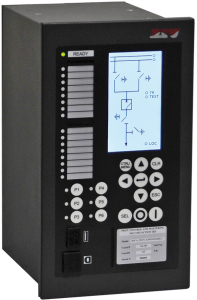- Potente lógica programable.
- Registro de 2000 eventos, hasta 100s de oscilografía.
- Display alfanumérico o gráfico. 144 ED, 63 SD y 22 LEDs.
- Redundancia Bonding, RSTP, PRP y HSR.
- Protocolos IEC 61850 Ed. 2, DNP3.0, Modbus RTU y PROCOME.
- Bus de proceso nativo. Las tarjetas de canales analógicos operan como Merging Units para la CPU (muestras a 4800 Hz (IEC 61869-9) y sincronizadas).
- Ciberseguridad conforme a estándares IEC 62351, IEC 62443 e IEEE 1686-2013. RBAC, claves seguras, inhabilitación de puertos físicos y lógicos,registro de eventos de ciberseguridad, securizaciónde los protocolos de gestión (PROCOME, HTTPS, SFTP, SSH), autenticación remota (LDAP, RADIUS) y securización del firmware.
- Sincronización por IRIG-B, SNTP y PTP (Ordinary Clock / Transparent Clock).
Comunicación
La comunicación entre las unidades de posición y la unidad central se basa en IEC 61869-9 SV e IEC 61850-8-1 GOOSE. Las unidades de posición se sincronizan mediante PTP IEC 61850-9-3. El reloj maestro puede ser la propia unidad central o un dispositivo externo. Se puede utilizar comunicación redundante basada en HSR o PRP. Estas características permiten que la protección diferencial distribuida (DBF) sea aplicable tanto a subestaciones digitales como convencionales.
Adaptable a cualquier configuración de subestación
El DBF puede aplicarse a cualquier configuración de subestación, soportando hasta 4 barras, incluidas dos barras de transferencia, con hasta 4 acoplamientos, con transformadores de corriente (CT) simples o dobles y hasta 24 posiciones.
Unidad diferencial principal
El DBF incluye 4 unidades diferenciales principales, con frenado porcentual y doble pendiente. La unidad diferencial presenta tiempos de disparo típicos en subciclo.
Detector de falta externa
Este detector se basa en la relación entre la intensidad diferencial instantánea y la intensidad de frenado, además de dos unidades de comparación direccional. Permite bloquear la unidad diferencial en presencia de faltas externas con saturación severa de los transformadores de intensidad (TI), proporcionando alta seguridad.
Unidad de alarmas
Esta unidad permite detectar ITs abiertos, bloqueando la unidad diferencial principal cuando sea necesario.
Unidad de supervisión
Considera todas las posiciones de la subestación para evitar disparos falsos de las unidades diferenciales principales debido a estados erróneos en los contactos secundarios de los seccionadores de la barra.
Zona dinámica
La lógica de zona dinámica mejora la seguridad y la confiabilidad en faltas ubicadas entre el transformador de intensidad (TI) y el interruptor cuando este último está abierto. La lógica elimina la intensidad de la posición en el cálculo diferencial para acelerar los disparos si el TI está en el lado de la barra y bloquea el disparo si el TI está en el lado de la línea.
Solución rentable
Las unidades de posición no solo funcionan como SV publishers y GOOSE publishers/subscribers, sino que también pueden utilizarse como IEDs de Protección y Control, ya que pueden ejecutar funciones de protección de un relé de alimentador. Esto hace que esta solución sea muy rentable para la protección diferencial de barras de media tensión (MT).


